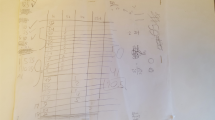Abstract
Based on Châtelet’s insights into the nature of mathematical inventiveness, drawn from historical analyses, we propose a new way of framing creativity in the mathematics classroom. The approach we develop emphasizes the social and material nature of creative acts. Our analysis of creative acts in two case studies involving primary school classrooms also reveals the characteristic ways in which digital technologies can occasion such acts.










Similar content being viewed by others
References
Burbules, N. C. (2006). Rethinking the virtual. In J. Weiss, et al. (Eds.), The International handbook of virtual learning environments (pp. 37–58). Dordrecht, The Netherlands: Springer.
Châtelet, G. (1993). Les enjeux du mobile. Paris: Seuil.
Châtelet, G. (2000). Figuring space: philosophy, mathematics and physics. (trans: Shore, R., & Zagha, M.). Dordrecht: Kluwer
Clagett, M. (1968). Nicole Oresme and the medieval geometry of qualities and motions. Madison: The University of Wisconsin Press.
Davis, G. A., & Rimm, S. B. (2004). Education of the gifted and talented (5th ed.). Boston: Pearson Education.
De Freitas, E., & Sinclair, N. (2012). Diagram, gesture, agency: theorizing embodiment in the mathematics classroom. Educational Studies in Mathematics, 80, 133–152.
Deleuze, G. (1994). Difference and repetition (trans: Patton, P.). New York: Columbia University Press.
Ferrara, F., Pratt, D., & Robutti, O. (2006). The role and uses of technologies for the teaching of algebra and calculus. In A. Gutierrez & P. Boero (Eds.), Handbook of research on the psychology of mathematics education (pp. 237–273). Rotterdam: Sense.
Jackiw, N. (2006). Mechanism and magic in the psychology of dynamic geometry. In N. Sinclair, D. Pimm, & W. Higginson (Eds.), Mathematics and aesthetics: New approaches to an ancient affinity. New York: Springer.
Leikin, R. (2009). Multiple proof tasks: Teacher practice and teacher education. In Proceedings of ICMI Study-19: Proofs and proving.
Leikin, R., Berman, A., & Koichu, B. (Eds.) (2009). Creativity in mathematics and the education of gifted students. Rotterdam, The Netherlands: Sense.
Nemirovsky, R., & Ferrara, F. (2009). Mathematical imagination and embodied cognition. Educational Studies in Mathematics, 70, 159–174.
Papert, S. (1980). Mindstorms: Children, computers and powerful ideas. New York: Basic Books.
Plucker, J. A., & Beghetto, R. A. (2004). Why creativity is domain general, why it looks domain specific, and why the distinction does not matter. In R. J. Sternberg, E. L. Grigorenko, & J. L. Singer (Eds.), Creativity: From potential to realization (pp. 153–168). Washington, DC: American Psychological Association.
Rotman, B. (2008). Becoming beside ourselves: The alphabet, ghosts, and distributed human beings. Durham: Duke University Press.
Torrance, E. P. (1974). Torrance tests of creative thinking. Bensenville, IL: Scholastic Testing Service.
Weil, A. (1992). The apprenticeship of a mathematician (trans: Gage, J.). Berlin: Birkhäuser.
Author information
Authors and Affiliations
Corresponding author
Rights and permissions
About this article
Cite this article
Sinclair, N., de Freitas, E. & Ferrara, F. Virtual encounters: the murky and furtive world of mathematical inventiveness. ZDM Mathematics Education 45, 239–252 (2013). https://doi.org/10.1007/s11858-012-0465-3
Accepted:
Published:
Issue Date:
DOI: https://doi.org/10.1007/s11858-012-0465-3




